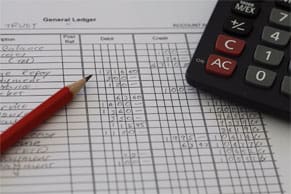Bookkeeping is a necessary, but often unpopular, job that handles the recording of financial transactions. It generally falls under accounting in larger companies; in smaller, growing businesses, the bookkeeper role is just one of many hats their owners often wear. In fact, almost half of small business owners personally handle all of their company's accounting and financial functions, according to several studies.
But whoever is filling the role, accurate, up-to-date bookkeeping is critical to a business's financial well-being. Good bookkeeping practices also help companies avoid pitfalls like tax audits, poor cash flow and business failure. The 13 bookkeeping hacks that follow can help reduce the time and effort required to keep financial records current, both for "real" bookkeepers and do-it-yourselfers.
13 Bookkeeping Hacks to Adopt
Strong financial management starts with solid financial data to help inform better decisions. These bookkeeping hacks, or tips, support good bookkeeping hygiene, regardless of a company's size or industry. They can also save time and money and reduce frustration.
1. Separate business and personal transactions: This is important for all types of companies — and legally required for LLCs, partnerships and corporations. Keeping personal and business expenses separate also provides the clearest picture of a company's financial health. For good bookkeeping, this is best achieved by opening a commercial bank account and using a corporate credit card for all purchases. Setting these services up generally require companies to provide an employer identification number or, for solopreneurs, a social security number.
2. Reconcile regularly: Reconciling accounts — or comparing two sets of financial records to ensure they match — on a regular basis helps catch bookkeeping errors and omissions. Types of reconciliations include bank reconciliation, which compares cash balances and bank statement details with the transactions recorded in your accounting system; and accounts-receivable reconciliation, which compares customer payments to open invoices. Shorter spans between reconciliations means fewer transactions to review at any given time, making the task less cumbersome and time-consuming. Frequent reconciliation also helps catch and correct potential problems sooner. Aim for weekly reconciliations on key accounts.
3. Invest in accounting software: Accounting software is a must-have for businesses of all sizes and for bookkeepers of all abilities. Basic accounting software keeps financial data organized and accounts balanced, and may also include limited automation features such as the ability to link with bank and credit card accounts or create journal entries from digital receipts using OCR. These added capabilities reduce the time needed for data entry.
Higher-level accounting software provides additional features, including automated workflows, robust financial controls, more extensive reporting capabilities, and mobile access. Some solutions extend beyond support for a company's bookkeeping needs by providing an integrated set of business modules to meet additional requirements as a company grows. A related tip: Take the software training and set-up seriously. Understanding how to use and leverage the investment in accounting software can reap many benefits and help avoid costly mistakes.
4. Link bank and credit card accounts: For efficient bookkeeping, link business bank accounts and credit cards to the accounting software. This will allow transactions to automatically flow into the accounting system, reducing the risk of manual data entry errors. Take this hack a step further by setting up rules in the accounting system that automatically post bank and credit card transactions to the appropriate general ledger account. This kind of automation saves time and increases efficiency by eliminating the need to enter every transaction by hand.
5. Organize and digitize receipts immediately: Eliminate nightmarish stacks of paper and shoeboxes full of crumpled receipts with two related hacks. First, make use of digital payment methods whenever possible so that each transaction is captured and automatically fed from linked business bank and business credit card accounts into the accounting system. Second, scanning unavoidable paper receipts, either via a smartphone app or desktop scanner, keeps them organized and reduces the likelihood of loss or physical deterioration. Lost receipts can prevent a company from deducting necessary expenses. The result is artificially inflated operating income and higher taxes. Organizing and digitizing receipts saves time and money, and will provide additional benefits for tax preparers.
6. Use financial statements: Financial statements provide a summarized picture of a company's financial health and can be generated from most accounting software. When used for financial analysis, they highlight business areas that are performing well and those that require attention. Although lenders may only require them periodically, it's best to generate financial statements on a regular basis to keep them current. Financial statements are also useful as a starting point for creating budgets and forecasts.
7. Categorize expenses: Categorizing and coding transactions to the appropriate general ledger account helps business leaders understand how a company generates incomes, how it invests capital and whether it's able to pay its debts. Accurate coding is also essential for tax and audit purposes. Assigning the correct code is easiest when the memory of the transaction is still fresh. Entering and categorizing transactions regularly also keeps the bookkeeping workload from becoming overwhelming. Ideally, a majority of transactions would be coded automatically based on predefined rules.
8. Adopt automation: Automation frees up precious time. Integrating credit card and bank accounts with an accounting system to facilitate automated reconciliation is just one of several bookkeeping hacks that can reduce the drudgery, effort and errors inherent in manual data entry. Another option is to use optical character recognition technology to convert text from physical documents, digital images and PDF files transactional accounting data automatically.
9. Set daily tasks: Setting daily tasks helps control the amount of time spent on bookkeeping and establishes a useful time-management routine. By doing a little bit each day, tasks won't pile up, become unwieldy and cause a time crunch that completely diverts attention from daily operations. This tip is equally relevant for seasoned bookkeepers and do-it-yourselfers.
10. Monitor accounts receivable: Keeping cash flowing into a business is critical. One bookkeeping hack that can help is the constant monitoring of accounts receivable to identify when certain customer accounts become past due and require proactive outreach. Timely collections efforts reduce the potential for lost revenue since the likelihood of collecting on past-due accounts deteriorates as they become ever more delinquent. (A related accounts-receivable tip: Apply cash received from customers to their outstanding invoices immediately to help avoid embarrassing collection calls that waste time and strain customer relationships.) Reconciling cash receipts and accounts receivable on a daily or weekly basis is recommended.
11. Always take notes: From Bookkeeping 101: Document everything in the moment. Take notes on conversations with customers, bankers and suppliers. Add descriptions to invoices and checks when first generated to avoid common invoicing problems. Relying on memories of purchases that fade over time is never a good idea, especially for business owners wearing several hats. Taking copious notes also helps others come up to speed more quickly in the event someone else needs to jump in.
12. Set measurable goals: Set longer-term measurable goals for how to handle the company's bookkeeping function beyond just the daily tasks. For example, predetermine an appropriate level of income or transaction volume that would prompt you to bring on additional bookkeeping help, or establish acceptable time limits for certain tasks that involve external deadlines, such as tax filings or loan compliance.
13. Forecast the future: Take a proactive bookkeeping approach to financial management to help shape the future of your company. Use the time unlocked by these bookkeeping hacks to identify new ways to boost the company's success. For example, use financial statements to attract investors or to exhibit creditworthiness to lenders or suppliers. Another example: Do financial analysis to spot trends and develop plans to exploit or mitigate them.
Simplify Bookkeeping with the Right Tools
Bookkeeping can be an arduous, time-consuming and underappreciated activity, especially for small business owners who do it themselves and for whom every dollar counts. Embracing automation and using the right accounting software constitute a big part of the solution. When combined with the bookkeeping hacks listed above, precious time can be recaptured and redirected to help a business thrive.
#1 Cloud
Accounting
Software
Bookkeeping FAQs
How can I make bookkeeping easier?
The most impactful way to make bookkeeping easier is to use accounting software that has a high level of integration and automation. Increasing the level of automation can reduce the overall bookkeeping workload and decrease the potential for manual errors.
Can I teach myself bookkeeping?
Bookkeeping does not require a particular degree or certification and can be self-taught. Many online, offline and in-person educational tools are available, including customer support supplied by accounting software vendors.
What are the two main ways bookkeeping can be completed?
Two types of bookkeeping are the single-entry method and the double-entry method. Single-entry bookkeeping lists transactions, like a check register or bank statement, and is typically used with the cash basis of accounting. Double-entry accounting is a system of balanced debits and credits used by most companies under the accrual basis of accounting. Both types of bookkeeping can be done either manually or in a computerized environment. Most companies use computerized accounting systems.
How do I perform bookkeeping for a small business?
Bookkeeping is the process of recording a business's financial transactions. Basic steps include categorizing revenue and expenses, and posting activity into a company's general ledger, in accordance with the cash or accrual basis of accounting.









